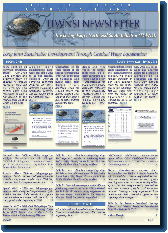 |
In this issue: - New edition of TLWNSI’S WORKING DRAFT. Our living wage concept and argumentation to support it remains exactly the same, but our strategy and tactics have been redesigned to have a full bearing on the marketocratic ethos in which we are living;
- Argentina’s manufacturing living-wage gap: – still a ways to go but steadily closing in – After the complete economic debacle of 2002, Argentina is enjoying a substantial recovery and real wages are at their best level ever;
- Observations on the Final Report of the Special Representative of the UN on the issue of business and human rights, John Ruggie. If TNLs benefited when the Norms Draft was buried, Ruggie’s Final Report is once again a ploy so that everything remains the same;
- Mexico and living wages: the utmost epitomization of social darwinism as a systemic public policy – Undemocratic imposed policies provide irrefutable testimony of the deliberate transformation of Mexican workers into labour - bondage disposable items;
- Aequus Indices. Living Wage Equalisation in the manufacturing sector. The most relevant indicator of our work exposes either the size of the gap or the advantage that real wages have over the wages of equivalent U.S. workers for up to 32 countries;
- New 2009 real living-wage gap analysis update for production workers in 12 economies and the U.S.. Our annual analysis 1975-2009, for 8 developed and 4 "emerging" economies, of wage gaps in PPP terms;
- Mexico's (1975-2009) Real Living-Wage Gap - The Mexican State, still challenged for the lack of legitimacy of its election, corroborates every year its vocation as a customary violator of the labour rights of its citizens;
- Brazil's (1975-2009) Real Living-Wage Gap - Brazil’s recovery of production-line manufacturing wages recedes since 2006. Yet, there are plans for long-term equalisation;
- Spain's (1975-2008) Real Living-Wage Gap - Maintaining the European trend, Spain sustains the size of the equalisation gap for production-line real wages with the U.S., but the gap will widen beginning in 2010;
- Table T4: 1975 - 2009 - Real-Wage Gaps for Twelve Economies, in Purchasing Power Parity (PPP) Terms, for production-line Manufacturing Workers;
- Table T4: 1975 - 2009 - Real-Wage Gaps for European Economies, in Purchasing Power Parity (PPP) Terms, for production-line Manufacturing Workers;
- Table T4: 1975 - 2009 - Real-Wage Gaps for Asia & Oceania Economies, in Purchasing Power Parity (PPP) Terms, for production-line Manufacturing Workers;
- Table T5: Living-wage gaps 1996-2009 – in purchasing power parity terms (PPPs)– vis-à-vis the U.S. for all manufacturing employees for the four largest economies in the Americas (Canada, Brazil, Mexico and Argentina)!;
- ILO’s International Journal of Labour Research. Towards a sustainable recovery: The case for wage-led policies.;
- OECD Watch – OECD Watch statement on the update of the OECD Guidelines for MNEs – Improved content and scope, but procedural shortcomings remain;
- Human Development Report 2011. Sustainability and Equity: A Better Future for All. Sustainability is inextricably linked to basic questions of equity, fairness and social justice and of greater access to a better quality of life. Approaches that integrate equity into policies and that empower people hold enormous promise. Growing country experiences have demonstrated their potential to generate and capture positive synergies;
- 2011 Top Ten Resource Downloads. The top Internal and External Resources Downloaded From Our Website in 2011;
- A Final Thought.
TOP
New edition of TLWNSI’S WORKING DRAFT
Our strategy and tactics have been redesigned to have a full bearing on the marketocratic ethos in which we are living.
The idea of The Living Wages North and South Initiative (TLWNSI) emerged in 1999 as a result of an open dialogue between numerous 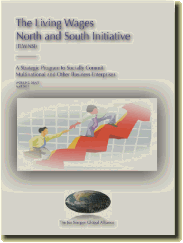 social activists, primarily in Mexico, the U.S. and Spain. It was conceived as a result of the need to address a very conspicuous question: why do workers in Southern countries, who work for global corporations, earn a miserable wage by any standard, whilst their counterparts in Northern countries earn a living wage for doing the same job, of equivalent market value, for the same corporation? Our dialogue drew a first certainty: the wages paid to workers in the South have nothing to do with the cost of living differentials between economies; rather, they have to do with the logic of comparative advantages that puts supply and demand arguments to work on behalf of a global market system that practices labour exploitation as a core strategic asset of its global operations model. social activists, primarily in Mexico, the U.S. and Spain. It was conceived as a result of the need to address a very conspicuous question: why do workers in Southern countries, who work for global corporations, earn a miserable wage by any standard, whilst their counterparts in Northern countries earn a living wage for doing the same job, of equivalent market value, for the same corporation? Our dialogue drew a first certainty: the wages paid to workers in the South have nothing to do with the cost of living differentials between economies; rather, they have to do with the logic of comparative advantages that puts supply and demand arguments to work on behalf of a global market system that practices labour exploitation as a core strategic asset of its global operations model.
Our new strategy and tactics address the logic of the market in sync with a wide global movement of civil society organisations so that we can realistically expect to gradually transition from the current market-driven paradigm into the new true-democracy para-digm in the term of thirty years. It goes without saying that said paradigm can only have as its only purpose the pursuit of the welfare of people and planet and not the market. Download TLWNSI’s latest working draft! here!
TOP
ARGENTINA’ S MANUFACTURING LIVING-WAGE GAP: STILL A WAYS TO GO BUT STEADILY CLOSING IN
After the complete economic debacle of 2002, Argentina is enjoying a substantial recovery and real wages are at their best level ever. Yet, they still have considerable ground to cover before becoming of a living-wage kind; a goal that is realistically attainable in less than a decade if Argentina is able to sustain the current trend and control inflation. Argentina traditionally enjoyed the highest standard of living in Iberian America for most of the XX century. It had the most literate and well fed population, vast agricultural and mineral resources and a large immigration force eager to thrive in this new land. In the first part of the century, although the economy was 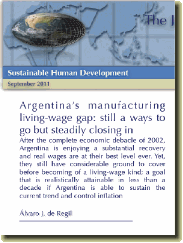 heavily dependent for foreign exchange on the export of agricultural products, Argentina was considered one of the richest countries in the world. Real wages had a very favourable gap vis-a-vis real wages in many countries in Europe, a factor that attracted millions of European immigrants to populate much of its, until then, scarcely populated territory. heavily dependent for foreign exchange on the export of agricultural products, Argentina was considered one of the richest countries in the world. Real wages had a very favourable gap vis-a-vis real wages in many countries in Europe, a factor that attracted millions of European immigrants to populate much of its, until then, scarcely populated territory.
However, during the second part of the century, despite its focus on industrialisation through import substitution, Argentina experienced a long period of recurring political and economic crises, with high inflation rates becoming a permanent feature of its economy. Military coups, deteriorating terms of trade for its agricultural exports and an inconclusive import substitution strategy did not allow Argentina to become a developed economy and instead descended into a middle income economy with a deteriorated standard of living and increased inequality.
At the end of the eighties, and in line with the global trend, particularly radical in Iberian America, Argentina adopted the recipes of the so-called Washington Consensus. This entailed the imposition of the supply-side neoliberal mantra through trade liberalisation, privatisation and the reduction of the State to its minimum expression.
Under the new paradigm Argentina experienced a short bout of economic boom at the end of the century. But in 2001, the laissez-faire opening of Argentina’s economy actually resulted in its complete collapse due to the sheer speculative and predatory basis upon which it was anchored. With “el corralito” –the actual freezing of all bank deposits due to lack of funds provoked by massive capital flight– Argentina was forced to declare a credit default of its large and mostly securitised foreign debt. As a consequence, since 2003, Argentina has moved from sheer laissez-faire to far more cautious economic policies –with some measure of regulation, and a less privatised and a more demand-side economic approach.
Since then real wages have improved dramatically in line with the unprecedented sustained economic recovery that began in 2003. As a result, manufacturing real wages in particular are at their highest level since at least 1996, more than doubling their previous real value during the short neoliberal boom. By the same token, since 2003 the living-wage gap vis-à-vis equivalent real wages in the U.S. has decreased dramatically as well and, as could be expected, it is much smaller than comparable manufacturing wage gaps among its counterparts in Brazil and Mexico, the largest economies in the region.
Nonetheless, from TLWNSI’s (The Living Wages North and South Initiative) living-wage perspective, before Argentina’s real wages in the manufacturing sector can be considered of a living-wage kind, they still have considerable ground to cover to reach the levels of Western Europe and East Asian wages. Yet, if Argentina is able to sustain the current trend, it will cross the living wage threshold in less than a decade at a gradual pace and will attain comparable wages –in living-wage terms– to those of Western European and East Asian countries. A realistic goal indeed. Download the assessment of Argentina's living-wage gap here!
TOP
Observations on the Final Report of the Special Representative of the UN on the issue of business and human rights, John Ruggie
If TNLs benefited when the Norms Draft was buried, Ruggie’s Final Report is once again a ploy so that everything remains the same This assessment arrives at a paramount conclusion: there is a deliberate policy in place to pauperise Mexico’s work force, to serve as a source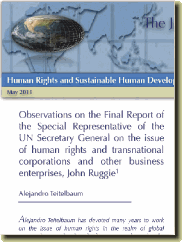 of the most competitive labour cost possible in the neoliberal globalised division of labour. Such conclusion is the result of assessing the quality of Mexico’s manufacturing wages, gauging the trend they have followed from 1975 to 2009 for production-line workers and from 1996 to 2009 for all people employed in the manufacturing sector. of the most competitive labour cost possible in the neoliberal globalised division of labour. Such conclusion is the result of assessing the quality of Mexico’s manufacturing wages, gauging the trend they have followed from 1975 to 2009 for production-line workers and from 1996 to 2009 for all people employed in the manufacturing sector.
Additionally, this work makes two projections exploring two different scenarios to close the huge wage gap of Mexican production workers with the wages of equivalent workers in the U.S. The first projection will assess what kind of real wage average annual increase it would take to close the wage gap with equivalent U.S. wages in the term of thirty years. The second projection assesses how long it would take to close the same wage gap by following Brazil’s concept of annually increasing nominal wages by the sum of inflation plus GDP growth. Both projections are fully in line with TLWNSI’s concept of equal pay for equal work of equal value through gradual wage equalisation.
Yet, currently the questions posed by these projections are undoubtedly rhetorical questions. Indeed, closing the gap to make Mexican wages of a living wage kind will remain an absolutely impossible endeavour as long as Mexican society does not get the resolve to organise to peacefully remove from power the structures that have historically been working to maintain the centre-periphery relationship that keeps all the benefits from economic activity for the robber barons and their foreign neoliberal tutors. Or, as the citizenry worldwide is increasingly denouncing, as long as the 1% keeps taking most of what belongs to the 99%. Download Teitelbaum’s final assessment on Ruggie’s work here.
TOP
Mexico and living wages: the utmost epitomization of social darwinism as a systemic public policy
The policies undemocratically imposed by the governments entrenched in power for the past thirty years provide irrefutable testimony of their deliberate transformation of Mexican workers into labour-bondage disposable items
This assessment arrives at a paramount conclusion: there is a deliberate policy in place to pauperise Mexico’s work force, to serve as a source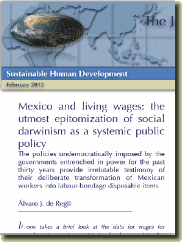 of the most competitive labour cost possible in the neoliberal globalised division of labour. Such conclusion is the result of assessing the quality of Mexico’s manufacturing wages, gauging the trend they have followed from 1975 to 2009 for production-line workers and from 1996 to 2009 for all people employed in the manufacturing sector. of the most competitive labour cost possible in the neoliberal globalised division of labour. Such conclusion is the result of assessing the quality of Mexico’s manufacturing wages, gauging the trend they have followed from 1975 to 2009 for production-line workers and from 1996 to 2009 for all people employed in the manufacturing sector.
Additionally, this work makes two projections exploring two different scenarios to close the huge wage gap of Mexican production workers with the wages of equivalent workers in the U.S. The first projection will assess what kind of real wage average annual increase it would take to close the wage gap with equivalent U.S. wages in the term of thirty years. The second projection assesses how long it would take to close the same wage gap by following Brazil’s concept of annually increasing nominal wages by the sum of inflation plus GDP growth. Both projections are fully in line with TLWNSI’s concept of equal pay for equal work of equal value through gradual wage equalisation.
Yet, currently the questions posed by these projections are undoubtedly rhetorical questions. Indeed, closing the gap to make Mexican wages of a living wage kind will remain an absolutely impossible endeavour as long as Mexican society does not get the resolve to organise to peacefully remove from power the structures that have historically been working to maintain the centre-periphery relationship that keeps all the benefits from economic activity for the robber barons and their foreign neoliberal tutors. Or, as the citizenry worldwide is increasingly denouncing, as long as the 1% keeps taking most of what belongs to the 99%. Download here the detailed assessment on the state of Mexico’s wages here!
TOP
Aequus Indices. Living Wage Equalisation in the manufacturing sector
The most relevant indicator of our work exposes either the size of the gap or the advantage that real wages have over the wages of equivalent U.S. workers for up to 32 countries
From inception, TLWNSI developed its living-wage equalisation index, which measures how close the real wages of manufacturing workers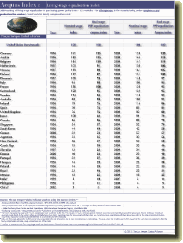 in a specific country are to those of equivalent workers in the U.S. in purchasing-power-parity (PPP) terms. The index exposes either the size of the gap or, in some countries, the true compensation advantage that real wages have over the wages of equivalent U.S. workers. Given that in 2011 we expanded our list of 13 economies included in our living-wage assessments to up to 32 economies, we decided to convey the most relevant indicator of our work in a very explicit manner. Hence we have named our index the "Aequus Index", Latin for "equal" or "balanced", which accurately reflects the purpose of our index. in a specific country are to those of equivalent workers in the U.S. in purchasing-power-parity (PPP) terms. The index exposes either the size of the gap or, in some countries, the true compensation advantage that real wages have over the wages of equivalent U.S. workers. Given that in 2011 we expanded our list of 13 economies included in our living-wage assessments to up to 32 economies, we decided to convey the most relevant indicator of our work in a very explicit manner. Hence we have named our index the "Aequus Index", Latin for "equal" or "balanced", which accurately reflects the purpose of our index.
In doing so we provide two indices. The first index measures wage differences for all employees in the manufacturing sector, which includes all persons employed full or part time in an establishment during a specified payroll period. The second index measures differences for production workers, which refers to only those employees who are engaged in activities directly or closely related to the production process.
Both criteria belong to the methodology used by the Bureau of Labour Statistics (BLS) of the U.S. Department of Labour, our source for all nominal wages included in the indices. Yet, this will be the last time that we produce the Aequus Index for production workers, the same measurement that we have assessed since 2003 for 12 economies. The BLS has decided to no longer update wage data for production workers. We will, however, maintain this table readily available, given that it provides wage data as far back as 1975, allowing us to provide a comparison for many countries between that year and, in most instances, 2009. The index for all employees dates back, depending on the country, to 1996 and, except for India and China, compares the benchmark year with 2009 and will continue to be updated every year. India and China's wage data is currently available for the periods 1999-2007 and 2002-2008 respectively. A word of caution, nonetheless, is required with these data, for India and China data gathered by the BLS are not fully comparable to the rest of countries due to some inconsistencies in methodology. However, given that in both cases the BLS argues that this does not substantially affect the hourly compensation estimates, rough comparisons can still be made, and thus, we have decided to include them in our Aequus Index. Download the 1996-2009 Aequss Index for All Employees here!
Download the 1975-2009 Aequss Index for Production Workers here!
TOP
NEW 2009 REAL LIVING-WAGE GAP ANALYSIS UPDATE FOR PRODUCTION WORKERS IN 12 ECONOMIES AND THE U.S.
Our annual analysis 1975-2009, for 8 developed and 4 "emerging" economies, of wage gaps in PPP terms Since 2008 Japan began to experience a strong revaluation of the yen with little increase in the PPP cost of living. This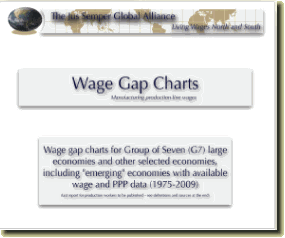 enabled Japan to record in 2009 its best living wage equalisation level ever (15% living-wage gap). In contrast, since 2007, most countries experienced substantial currency devaluations, strong PPP growth or real wage increases below the growth of U.S. wages. Thus, except for Italy and Hong Kong, which managed to sustain their previous equalisation, all the other countries increased their hourly compensation costs gaps with the U.S. in 2009. enabled Japan to record in 2009 its best living wage equalisation level ever (15% living-wage gap). In contrast, since 2007, most countries experienced substantial currency devaluations, strong PPP growth or real wage increases below the growth of U.S. wages. Thus, except for Italy and Hong Kong, which managed to sustain their previous equalisation, all the other countries increased their hourly compensation costs gaps with the U.S. in 2009.
Always relative to 2007, South Korea, the UK and Mexico experienced strong devaluations of their currencies in 2009 and meaningful decreases in their PPP costs of living, but devaluations were deep enough to offset all other factors and, consequently, increase their wage gaps. Canada performed worse for it was the only country in this assessment with a decrease in nominal wages in domestic currency. In this way, its equalisation index not only dropped substantially, but –after decades of equalisation surpluses– generated a gap with equivalent U.S. wages that had not existed since the late 1980s. The four countries recorded the worst performance of the twelve economies in this analysis, with Mexico getting close to its nadir (1995).
In the Euro Area real wages have barely moved since 2007. Thus, Germany, France and Spain lose some ground in their equalisation trends. Only Italy managed to increase real wages enough to maintain its previous equalisation index.
Brazil experienced a huge increase of 25%, since 2007, in its PPP cost of living. Consequently, real wages dropped and, thus, its living-wage gap increased four points from 63 to 67%. Singapore experienced a similar behaviour, which increased its gap from 50 to 53. Hong Kong barely managed to leave its living-wage gap at 32.
The analysis is an update for 12 economies and the U.S., prepared by TJSGA, using 2009 hourly compensation costs for manufacturing workers as reported by the U.S. Department of Labour, and PPP data from the World Bank and the OECD. The report exposes once again a global labour system that profits over the majority of the people in favour of a global elite. Download the pdf file with the wage gap update for 12 economies (Germany, France, Italy, Canada, U.K., Spain, Japan, South Korea, Singapore, Brazil, Hong Kong and Mexico). TOP
Mexico's (1975-2009) Real Living-Wage Gap
The Mexican State, still challenged for the lack of legitimacy of its election, corroborates every year its vocation as a customary violator of the labour rights of its citizens Once again, the following assessment may seem redundant to those who have read our analyses of previous years. Yet the 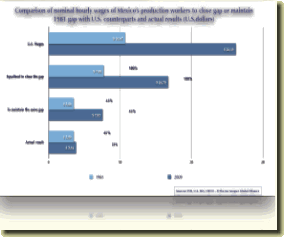 stubborn policy of the government in power –which deliberately pauperises the Mexican labour force– compels us to insist on the same assessment that exhibits the nefarious consequences of such policy. Moreover, it is necessary to depict once again the political context in which it is imposed. Assessing the wage data of the manufacturing sector of thirty-five years, irremediably exhibits the exploitative and repressive character of the group that has wielded real power for the last three decades. A group that has completely submitted itself to the Washington Consensus, with the goal of remaining in power. This has engendered an environment that stands out on a global scale for the tremendous erosion of labour rights. The illegitimate and mafia-like nature that accurately delineates the Mexican State, has imposed an ethos of labour bondage that takes the country back to conditions prevailing before the social revolution of 1910. stubborn policy of the government in power –which deliberately pauperises the Mexican labour force– compels us to insist on the same assessment that exhibits the nefarious consequences of such policy. Moreover, it is necessary to depict once again the political context in which it is imposed. Assessing the wage data of the manufacturing sector of thirty-five years, irremediably exhibits the exploitative and repressive character of the group that has wielded real power for the last three decades. A group that has completely submitted itself to the Washington Consensus, with the goal of remaining in power. This has engendered an environment that stands out on a global scale for the tremendous erosion of labour rights. The illegitimate and mafia-like nature that accurately delineates the Mexican State, has imposed an ethos of labour bondage that takes the country back to conditions prevailing before the social revolution of 1910. The future of production-line manufacturing wages in Mexico is absolutely ominous unless society removes from power those who have imposed the Mafia State and impose a citizen’s government of real democracy. Every year the government’s economic policies contain or further erode real wages. Additionally, the State has unleashed a policy of repression of the rights of freedom of association and to organise and collective bargaining. The deep impoverishment of Mexicans is a fact. Official data acknowledge that 81% of Mexicans are poor (Coneval 2009). By the same token, in 2009 the minimum wage was able to afford 17,5% of the 40 goods of the CBI or indispensable basket of goods, down from 49% in 1994, a 64% loss of purchasing power in 15 years, which is deemed essential for survival. Moreover, the government began 2010 and 2011 with strong price increases in the energy sector, which guarantee a greater pauperisation of real wages. Thus, parting from these findings, it is estimated –with a great degree of confidence– that less than 10% of all salaried workers can afford the CBI in 2011.
This prospectus remains with exactly the same tone conveyed in the 2007 and 2008 reports, for the deprivation, depredation and deliberate pauperisation –as a State policy– continue deepening.
In summary, more than a quarter century of predatory capitalism in Mexico exposes, decisively, a government's policy –from the perspective of manufacturing wages in particular and all wages in general– of perverse and premeditated pauperisation and exploitation of Mexican labour, for the only public policy of the Mafia State is to govern for the benefit of domestic and foreign institutional investors and their corporations. In this way, as long as the “robber baron” elites currently in power remain in control, the deepening of the pauperisation of Mexico’s population is more than guaranteed, in such a way that the odds in favour of making the closing of Mexico’s living-wage gap a reality in the term of thirty years is currently zero. Download the pdf file with the analysis of Mexico's wage gap here. TOP
Brazil's (1975-2009) Real Living-Wage Gap Brazil’s recovery of production-line manufacturing wages recedes since 2006. Yet, there are plans for a strong long-term equalisation The future of Brazil’s wage policy is being redefined by clearly establishing a commitment to not only recover its 1996 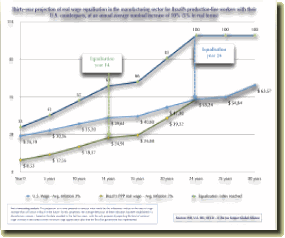 wage level but to equalise wages with equivalent wages in the U.S. This shows strong affinity with TLWNSI’s concept –of the gradual closing of wage gaps through annual real wage increments (increments of several points over inflation)– for a system of annual real minimum wage increases has already been implemented beginning in 2010 and until 2023. wage level but to equalise wages with equivalent wages in the U.S. This shows strong affinity with TLWNSI’s concept –of the gradual closing of wage gaps through annual real wage increments (increments of several points over inflation)– for a system of annual real minimum wage increases has already been implemented beginning in 2010 and until 2023.
Although Brazil’s plan will hardly close the wage gap with the United States by 2023, it will undoubtedly embody a great improvement that will trigger different multiplying effects that will generate the endogenous development of Brazil. This will place it much closer to the socioeconomic indicators of developed countries than of developing ones. Last year we were confident that once the benefits to be obtained from Brazil’s minimum wage appreciation policy were attested, the new government of Dilma Rousseff would maintain the same policy. But, sooner than expected, Rousseff’s government and Brazil’s Congress have already transformed into law the appreciation plan and seem committed to it despite the fact that the opposite policy, of wage depredation, is being pursued globally and with special emphasis in the European Union.
To be sure, there is no guarantee that the current minimum wage appreciation policy will be maintained by future Brazilian governments. In any case, the responsibility for making sure that this policy remains falls directly on society, which bears the full load for making Brazil’s future governments feel compelled to consolidate this objective. Hence, it is indispensable that Brazilians become fully aware about the need to permanently get involved in the public matter to make sure that future governments work for the benefit of society and not for the owners of the market and their very private interests, as the vast majority of governments enthusiastically pursue in most countries today. Download the pdf file with the analysis of Brazil's wage gap here.
TOP
Spain's (1975-2009) Real Living-Wage Gap
In 2009 Spain stays in line with the general trend followed by euro-driven economies, slightly sliding in their equalisation indices –since 2007– relative to U.S. wages. Yet, the slide in real wages will surely worsen in the entire euro area and even more so in Spain and other countries as the extreme austerity recession-side strategy that is being imposed ensue The gradual transformation of Spanish wages into living wages is bound to experience a hard regression to the levels recorded many years ago. As could be expected, the ensuing effects of the systemic global capitalist crisis began to exert a toll on real wages in the entire Euro area in 2009,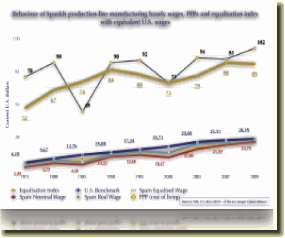 which continued in 2010 and 2011 and will be felt far more harshly from 2012 onward. Greece, Portugal, Italy, Ireland, Belgium and Spain have been forced to impose drastic economic policies that can no longer be considered supply sided or even recessionary but truly economically depressive. A euro-area policy centred on the harsh reduction of public-deficits to 3% of GDP by 2013, is drastically cutting budgets in all areas of government at both national and municipal levels. However, “coincidentally”, the new European Union directives are imposing, and not just demanding, a sheer neoliberal systemic restructuring which will deepen the already supply-side ethos that was gradually put in place in the 1990s. In complete incongruence with a truly democratic ethos, the new directives are now focused on reducing wages to the minimum common denominator and on dismantling many labour rights. As it happens, given that euro-area countries no longer have a national currency that could be devalued to increase competitiveness, and that the European Central Bank’s sole goal is to contain inflation, euro-area economic strategy to increase competitiveness is now exclusively anchored on wage pauperisation. Thus, euro-area workers are at a real disadvantage vis-à-vis the rest of the world. which continued in 2010 and 2011 and will be felt far more harshly from 2012 onward. Greece, Portugal, Italy, Ireland, Belgium and Spain have been forced to impose drastic economic policies that can no longer be considered supply sided or even recessionary but truly economically depressive. A euro-area policy centred on the harsh reduction of public-deficits to 3% of GDP by 2013, is drastically cutting budgets in all areas of government at both national and municipal levels. However, “coincidentally”, the new European Union directives are imposing, and not just demanding, a sheer neoliberal systemic restructuring which will deepen the already supply-side ethos that was gradually put in place in the 1990s. In complete incongruence with a truly democratic ethos, the new directives are now focused on reducing wages to the minimum common denominator and on dismantling many labour rights. As it happens, given that euro-area countries no longer have a national currency that could be devalued to increase competitiveness, and that the European Central Bank’s sole goal is to contain inflation, euro-area economic strategy to increase competitiveness is now exclusively anchored on wage pauperisation. Thus, euro-area workers are at a real disadvantage vis-à-vis the rest of the world.
Furthermore, there is now clear evidence that there is an ongoing deliberate assault on labour rights in the EU. In the past, wages were not in the domain of EU directives. However, Germany‘s economic paradigm, which is excessively centred on the containment of inflation and the absence of deficits, has made its policy to reduce wages and labour rights as the sole means to achieve its objective. Now, this policy has been effectively transferred to the euro area and it is being imposed even more profoundly as the new standard.
Indeed, the EU is also getting involved in reducing concrete and previously thought untouchable labour rights enshrined in the ILO’s core conventions, such as the EU’s direct meddling in the collective bargaining processes and actually dismantling collective bargaining models. In 2011 the members adopted the Euro-plus Pact, to speed up the dismantling of collective bargaining models as a legally-binding directive. The entire scheme is clearly a neoliberal approach designed to fulfil all the demands of international financial markets, now that governments, both left and right, no longer feel constrained to show their true face as market agents and consolidate the marketocratic ethos disguised as representative democracy. In line with the new neoliberal, undemocratic and regressive European Union assault on labour rights, Spain’s “labour” government passed a new labour reform in 2010 designed to comply with the new directives of the European Commission. It should be noted that Spain had already passed demand-side labour reforms in 1984, 1992, 1994, 1997, 2001 and 2006, all aimed at increasing flexibility in hiring and firing practices, reducing benefits and employer contributions, theoretically aimed at reducing unemployment by increasing temporary employment and similar practices that increased job insecurity and reduced labour rights. Then, in 2012 the new ultra neoliberal government immediately passed a new labour reform that deepens the flexibility of employers, so that they can hire and fire almost at will. Employers can now unilaterally opt to ignore their collective bargaining agreement with the union every time they record any drop in sales/revenue (not profits) in two consecutive quarters, and, among other things, layoff workers individually (less than 10% of the work force) or collectively if sales/revenue (not profits) drop at any rate in three consecutive quarters. Yet, the staunchest neoliberal change of the new reform is the inclusion of the right of employers to cut wages every time they record any loss of revenue/sales (not profits) in two consecutive quarters.
In summary, the capitalist systemic crisis has served to ensue a new assault on labour rights and the Welfare State in Spain and across the entire European Union. This will in all certainty decrease the workers’ share of income and increase the employers shareholder value in the coming years.
Download the pdf file with the analysis of Spain's wage gap here.
TOP
TABLE T4*: 1975 – 2009 REAL-WAGE GAPS FOR TWELVE ECONOMIES, IN PURCHASING POWER PARITY (PPP) TERMS, FOR PRODUCTION-LINE MANUFACTURING WORKERS (The base table used for all PPP real-wage gap analysis)
In 2009, the international comparison of hourly compensation costs for production-line (PL) workers between the U.S. 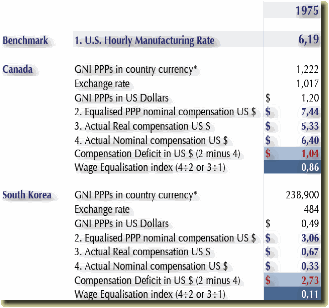 and selected developed and "emerging" markets, shows, relative to 2007, most countries markedly widening their gap with the wages of their U.S. counterparts or little or no change in their equalisation indices. Only Japan reported a marked improvement, recording its best equalisation index since 1975. This will be the last report for production workers. Beginning with 2010, the data will report labour costs for all manufacturing employees, including production workers. and selected developed and "emerging" markets, shows, relative to 2007, most countries markedly widening their gap with the wages of their U.S. counterparts or little or no change in their equalisation indices. Only Japan reported a marked improvement, recording its best equalisation index since 1975. This will be the last report for production workers. Beginning with 2010, the data will report labour costs for all manufacturing employees, including production workers.
Since 2008 Japan began to experience a strong revaluation of the yen with little increase in the PPP cost of living. This enabled Japan to record in 2009 its best living wage equalisation level ever. In contrast, the rest of the countries experienced substantial currency devaluations, strong PPP growth or real wage increases below the growth of U.S. wages, with respect to 2007. Thus, all the other countries increased their hourly compensation cost gaps with the U.S. except for Italy and Hong Kong, which managed to sustain their previous equalisation index.
Download the pdf file of Table 4 here.
TOP
TABLE T4-EUROPE: 1975 – 2009 REAL-WAGE GAPS FOR EUROPEAN ECONOMIES, IN PURCHASING POWER PARITY (PPP) TERMS, FOR PRODUCTION-LINE MANUFACTURING WORKERS
In assessing the competitiveness in the equalisation of European countries’ manufacturing wages (total hourly 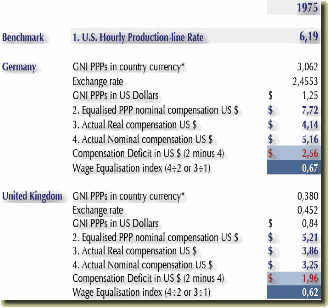 compensation costs) for production line (PL) workers –in purchasing power parity (PPP) terms– with equivalent U.S. wages, most countries lost ground in 2009 relative to their 2007 position. Only Switzerland was able to increase its advantage while Italy and Austria were able to sustain it. Most Euro countries lost some ground, despite a small currency revaluation, for nominal wages grew less than their PPPs. Other countries, prominently the UK. Sweden and Norway, suffered a large devaluation, which provoked a dramatic drop in their wage equalisation indices, with the UK recording the worst performance. compensation costs) for production line (PL) workers –in purchasing power parity (PPP) terms– with equivalent U.S. wages, most countries lost ground in 2009 relative to their 2007 position. Only Switzerland was able to increase its advantage while Italy and Austria were able to sustain it. Most Euro countries lost some ground, despite a small currency revaluation, for nominal wages grew less than their PPPs. Other countries, prominently the UK. Sweden and Norway, suffered a large devaluation, which provoked a dramatic drop in their wage equalisation indices, with the UK recording the worst performance.
In comparing 2009 with 2007 living-wage equalisations, there are four distinct groups defined by the behaviour of the key elements in wage equalisation: 1) those enjoying a considerable currency revaluation; 2) those with nominal wage increases –in local currency– marginally greater than the growth of their PPP cost of living and with small currency revaluations; 3) those with nominal wage increases –in domestic currency– smaller than the growth of their PPP cost of living and with small currency revaluations and 4) those with large currency devaluations.
Download the pdf file for Table 4 of wage gaps for European economies here.
TOP
TABLE T4-ASIA AND OCEANIA: 1975 – 2009 REAL-WAGE GAPS FOR ASIA AND OCEANIA, IN PURCHASING POWER PARITY (PPP) TERMS, FOR PRODUCTION-LINE MANUFACTURING WORKERS
In assessing the competitiveness in the equalisation of countries’ manufacturing wages (total hourly compensation costs) for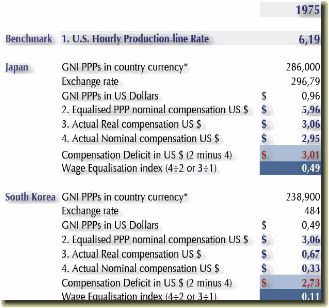 production-line workers –in purchasing power parity (PPP) terms– with equivalent U.S. wages, most countries in Asia and Oceania lost ground in 2009 relative to their 2007 position. Only Japan was able to increase its advantage due to a strong revaluation of the yen. Several countries, particularly South Korea, Australia and New Zealand suffered devaluations that dropped their equalisation indices. The rest lost some ground or were barely able to sustain their 2007 position. production-line workers –in purchasing power parity (PPP) terms– with equivalent U.S. wages, most countries in Asia and Oceania lost ground in 2009 relative to their 2007 position. Only Japan was able to increase its advantage due to a strong revaluation of the yen. Several countries, particularly South Korea, Australia and New Zealand suffered devaluations that dropped their equalisation indices. The rest lost some ground or were barely able to sustain their 2007 position.
In comparing 2009 with 2007 living-wage equalisations, most countries in Asia and Oceania lost ground in their equalisation indices because real wages in U.S. dollars dropped or grew less than equivalent U.S. wages. Broadly, when real wages in U.S. dollars dropped, they did it because real wages in domestic currency dropped or there were large currency devaluations. Exceptionally, Japan increased the value of the yen by more than 20% between 2007 and 2009. Thus, despite a drop in real wages –in PPP terms– real wages in U.S. dollars increased almost 19%. This caused its equalisation index to jump more than 22% (from 72 to 85) and to record its best position vis-à-vis equivalent U.S. wages since 1975. In fact, Japan recorded by far the best equalisation index performance of all countries in all regions.
Download the pdf file for Table 4 of wage gaps for Asia and Oceania economies here.
TOP
Table T5: New living-wage gaps 1996-2009 –in purchasing power parity terms (PPPs)– vis-à-vis the U.S. for all manufacturing employees for the four largest economies in the Americas (Canada, Brazil, Mexico and Argentina)!
The equalisation indices of hourly compensation costs for all manufacturing sector workers (AMWs) (blue & white collar) in Canada, Mexico, Brazil and Argentina, recorded an erosion of real wages and, thus, a widening of their wage gaps vis-à-vis equivalent U.S. workers with respect to 2008.
In observing changes in 2009, always with respect to 2008, all countries in the Americas included in this assessment 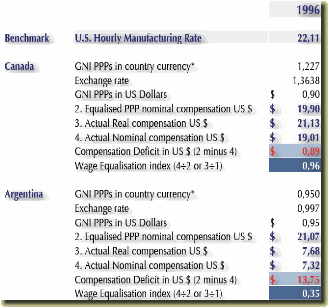 recorded currency devaluations against the U.S. dollar, averaging 11,9%, with Mexico recording the highest (17,5%) and Canada the lowest (6,6%). Argentina, Brazil and Mexico recorded nominal wage increases in domestic currency, whilst Canada’s nominal wages dropped 4,2%. Moreover, PPP costs of living relatively increased in Brazil and Argentina whilst slightly decreased in Mexico. All these factors combined to cause a drop of real wages in U.S. dollars (total hourly compensation costs) for all four countries, averaging 7,6% –vis-à-vis a 4% increase in U.S. wages– and, accordingly, an average drop in their equalisation indices of 11,1%. recorded currency devaluations against the U.S. dollar, averaging 11,9%, with Mexico recording the highest (17,5%) and Canada the lowest (6,6%). Argentina, Brazil and Mexico recorded nominal wage increases in domestic currency, whilst Canada’s nominal wages dropped 4,2%. Moreover, PPP costs of living relatively increased in Brazil and Argentina whilst slightly decreased in Mexico. All these factors combined to cause a drop of real wages in U.S. dollars (total hourly compensation costs) for all four countries, averaging 7,6% –vis-à-vis a 4% increase in U.S. wages– and, accordingly, an average drop in their equalisation indices of 11,1%.
Mexico’s strong devaluation of the peso against the dollar was enough to offset a 6,5% increase in nominal wages and a slight drop in its PPPs. Thus, its hourly manufacturing rate in U.S. dollars dropped more than 8% in real terms and, accordingly, its equalisation index dropped by almost 12%.
Argentina’s nominal wages increased by 20,2% in national currency and 14,8% in real PPP terms. Yet, a 15,2% currency devaluation and a 5,5% increase in its PPP cost of living triggered a small drop of real wages in dollar terms and a 7,1% decrease in its equalisation index with U.S. equivalent wages, always relative to 2008.
Download the pdf file for Table 5 of wage gaps for all employees in manufacturing in the Americas here.
TOP
RESOURCE CENTRE
ILO’s INTERNATIONAL JOURNAL OF LABOUR RESEARCH
Towards a sustainable recovery: The case for wage-led policies
This issue of the International Journal of Labour Research addresses a central issue, if not the key issue for the labour movement: that of 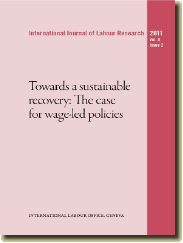 wages and what has happened to them over the past three decades. Clearly, the combination of restrictive macroeconomic policies, trade liberalisation and the financialisation of corporate governance has drastically changed the landscape in which collective bargaining takes place. In the North “concession bargaining” has become a familiar concept, and in the South, the shift in the balance of power has meant that workers are not able to capture the hard-earned fruits of economic growth. wages and what has happened to them over the past three decades. Clearly, the combination of restrictive macroeconomic policies, trade liberalisation and the financialisation of corporate governance has drastically changed the landscape in which collective bargaining takes place. In the North “concession bargaining” has become a familiar concept, and in the South, the shift in the balance of power has meant that workers are not able to capture the hard-earned fruits of economic growth.
This new context, by weakening labour market regulation both de jure and de facto has profoundly eroded trade unions’ ability to connect improvements in standard of living to productivity gains. This has resulted not only in increased wage and income inequalities and higher incidence of low pay, but also in an increasingly dysfunctional macroeconomic picture.
One of the main findings is that wage-led growth economic strategies, far from undermining growth as is argued by mainstream economists, would, on the contrary, improve growth rates. This is an important argument as it directly contradicts the current “competitiveness” policy orientation in much of the world – an orientation based on permanent wage moderation. Clearly, such a recovery can only materialise if there is a global rebalancing of wages and productivity. This will not only require that trade unions intensify their efforts at the bargaining table and in pushing for better minimum wages, but that they fight to change the new global “rules of the game” that are diametrically set against them. In this area, as for others, collective action is a sine qua non condition to achieving any success
Click here or on the picture to download the full Journal in a pdf file.
Click hereto download the French version of the Journal in a a pdf file.
TOP
OECD WATCH – OECD WATCH STATEMENT ON THE UPDATE OF THE OECD GUIDELINES FOR MNEs
Improved content and scope, but procedural shortcomings remain
OECD Watch welcomes the changes to the OECD Guidelines that confirm and broaden the scope of the instrument to the global activities and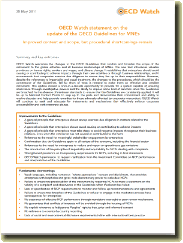 all business relationships of MNEs. The new text introduces valuable provisions on human rights, workers and wages, and climate change. It establishes that enterprises should avoid causing or contributing to adverse impacts through their own activities or through business relationships, and it recommends that companies exercise due diligence to ensure they live up to their responsibilities. However, despite the references to impartiality and equal treatment, the changes to the procedures, which should be the cornerstone of the Guidelines, fall far short of what is needed to make them an effective and credible instrument. This update missed a once-in-a-decade opportunity to provide for a system capable of ensuring observance through investigative powers and the ability to impose some kind of sanction when the Guidelines are breached. In the absence of minimum standards to ensure that the Guidelines are consistently applied, it will be up to National Contact Points to step up to the plate and demonstrate their commitment and ability to resolve disputes and help provide remedies for those adversely affected by corporate misconduct. OECD Watch will continue to seek and advocate for instruments and mechanisms that effectively enforce corporate accountability and curb corporate abuses. all business relationships of MNEs. The new text introduces valuable provisions on human rights, workers and wages, and climate change. It establishes that enterprises should avoid causing or contributing to adverse impacts through their own activities or through business relationships, and it recommends that companies exercise due diligence to ensure they live up to their responsibilities. However, despite the references to impartiality and equal treatment, the changes to the procedures, which should be the cornerstone of the Guidelines, fall far short of what is needed to make them an effective and credible instrument. This update missed a once-in-a-decade opportunity to provide for a system capable of ensuring observance through investigative powers and the ability to impose some kind of sanction when the Guidelines are breached. In the absence of minimum standards to ensure that the Guidelines are consistently applied, it will be up to National Contact Points to step up to the plate and demonstrate their commitment and ability to resolve disputes and help provide remedies for those adversely affected by corporate misconduct. OECD Watch will continue to seek and advocate for instruments and mechanisms that effectively enforce corporate accountability and curb corporate abuses.
Download the full assessment here!
TOP
Human Development Report 2011. Sustainability and Equity: A Better Future for All
Sustainability is inextricably linked to basic questions of equity, fairness and social justice and of greater access to a better quality of life. Approaches that integrate equity into policies and that empower people hold enormous promise. Growing country experiences have demonstrated their potential to generate and capture positive synergies
This Report explores the integral links between environmental sustainability and equity and shows that these are critical to expanding human freedoms for people today and in generations to come. The point of departure is that the remarkable progress in human development over recent decades that the Human Development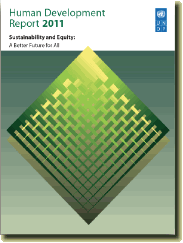 Report has documented cannot continue without bold global steps to reduce environmental risks and inequality. We identify pathways for people, communities, countries and the international community to promote environmental sustainability and equity in mutually reinforcing ways. Report has documented cannot continue without bold global steps to reduce environmental risks and inequality. We identify pathways for people, communities, countries and the international community to promote environmental sustainability and equity in mutually reinforcing ways.
The cover diagram symbolises how different policies can have different implications for sustainability and equity. Whenever available, we should prefer solutions that are good for the environment while also promoting equity and human development. Pursuing sustainability and equity jointly does not require that they be mutually reinforcing. In many instances they will not be. Sometimes the most feasible alternative involves trade-offs between sustainability and equity and requires explicit and careful consideration. No trade-off is isolated from a society’s structural and institutional conditions, and so we must address the underlying constraints and identify positive synergies between sustainability and equity. This Report is aimed not only at finding positive synergies but also at identifying ways to build them.
Yet there are alternatives to inequality and unsustainability. Growth driven by fossil fuel consumption is not a prerequisite for a better life in broader human development terms. Investments that improve equity— in access, for example, to renewable energy, water and sanitation, and reproductive healthcare— could advance both sustainability and human development. Stronger accountability and democratic processes, in part through support for an active civil society and media, can also improve outcomes. Successful approaches rely on community management, inclusive institutions that pay particular attention to disadvantaged groups, and cross-cutting approaches that coordinate budgets and mechanisms across government agencies and development partners.
Beyond the Millennium Development Goals, the world needs a post-2015 development framework that reflects equity and sustainability; Rio+20 stands out as a key opportunity to reach a shared understanding of how to move forward. This Report shows that approaches that integrate equity into policies and programmes and that empower people to bring about change in the legal and political arenas hold enormous promise. Growing country experiences around the world have demonstrated the potential of these approaches to generate and capture positive synergies.
Providing opportunities and choices for all is the central goal of human development. We have a collective responsibility towards the least privileged among us today and in the future around the world— and a moral imperative to ensure that the present is not the enemy of the future. This Report can help us see the way forward.
Download the pdf of the full report here or of the French version here.
TOP
2011 TOP TEN RESOURCE DOWNLOADS
Following is the chart with the top ten internal and external information resources downloaded from our website in 2011. Below the chart are the links for each of the top ten resources if you want to download them:
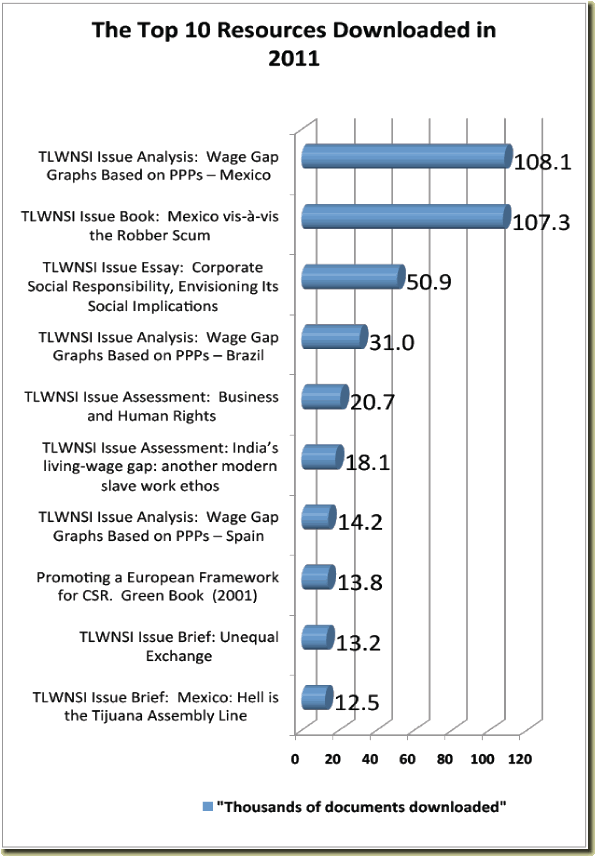
To download click below for the top ten downloads in 2011:
1. TLWNSI Issue Brief: Conditions and Evolution of Employment and Wages in Mexico
2. TLWNSI Issue Book: Mexico vis-à-vis the Robber Scum (Available in Spanish only)
3. TLWNSI Issue Essay: Corporate Social Responsibility, Envisioning Its Social Implications
4. TLWNSI Issue Analysis: Wage Gap Graphs Based on PPPs - Brazil
5. TLWNSI Issue Assessment: Business and Human Rights
6. TLWNSI Issue Assessment: India’s livingwage gap: another modern slave work ethos
7. TLWNSI Issue Analysis: Wage Gap Graphs Based on PPPs - Spain
8. Promoting a European Framework for CSR. Green Book (2001)
9. TLWNSI Issue Brief: Unequal Exchange
10. TLWNSI Issue Brief: Mexico: Hell is the Tijuana Assembly Line
TOP
A FINAL THOUGHT A living wage is, universally, the most important element in the achievement of everyone´s right to a dignified life and the eradication of poverty. Relative to the social responsibility of business, a corporation or organisational entity employing people, regardless of size or trade, public or private, cannot be considered to behave in a socially responsible manner if it does not pay a living wage, regardless of how responsibly it behaves in all other areas of activity. 
Mexico City policeman chains himself to the main doors
of the City Assembly in protest because his salary does not
make a living wage (19 December 2006).
Just as the International Labour Organisation's Decent Work Agenda states, the decent work concept has led to an international consensus that productive employment and decent work are key elements to achieving poverty reduction. Yet, everything remains in the realm of rhetoric and hypocrisy, and the system, imbued in the most perverse human instincts, remains.
Thank you so much for your support. If you have any questions or comments, Please e-mail us: gsc@jussemper.org
If you are not a member of our eCommunity yet, please click here to sign up for TJSGA's eCommunity to receive our quarterly newsletter. If you do not wish to continue receiving our quarterly newsletter, just e-mail us writing in the subject "unsubscribe" nosuscrip@jussemper.org.
TOP |  |







